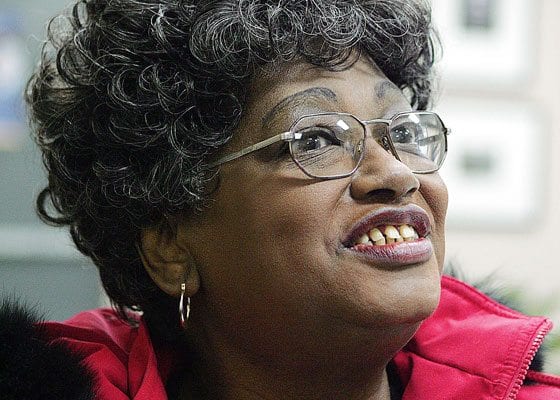

Author: APClaudette Colvin talks to reporters at Booker T. Washington Magnet School in Montgomery, Ala. in this Feb. 3, 2005 photo. As a 15-year-old high school student, Colvin refused to give up her bus seat to a white woman in Montgomery, nine months before Rosa Parks took her more famous stand.
PORTLAND, Maine — More than 50 years after her refusal to surrender her bus seat to a white woman set the stage for a similar act of defiance by Rosa Parks, Claudette Colvin is finally getting her due as a civil rights pioneer.
On March 2, 1955, the 15-year-old Montgomery, Ala., schoolgirl was dragged off the bus by police, handcuffed and jailed. But her bold act drew little support from classmates, many of whom shunned her, or from the city’s black leadership.
She went to court the following year as a plaintiff in a landmark lawsuit that both struck down the legal underpinnings for segregated buses in the Jim Crow South and ended the bus boycott that kick-started the civil rights movement. But even then she won scant recognition, and has remained a footnote to history.
When author Phillip Hoose stumbled upon Colvin’s story during research for a book on the role of young people in U.S. history, he thought it unjust that a brave girl who made such a contribution should be denied her place in history.
It took Hoose more than six years to track down Colvin, who was living in Bronx, N.Y., and get her to talk to him. But they finally met for a series of interviews that led to his new book, “Claudette Colvin: Twice Toward Justice.”
To mark its publication, Colvin and Hoose visited Montgomery and Birmingham last Tuesday and Wednesday for appearances that included stops at her old high school and the Rosa Parks Museum. The two will also be in Portland, Maine, the author’s hometown, Feb. 23-25.
The book, told in part in Colvin’s own voice, relates how the humiliations she endured on a daily basis while riding the bus to and from Booker T. Washington High School fueled her refusal to heed the driver’s order to vacate her seat.
Even now, however, she’s not sure what prompted that defiance.
“I really don’t know,” said Colvin, now 69. “It was a very impulsive act.”
She noted, however, that the incident came on the heels of her school’s Negro History Month, when accounts of the slave trade and lynchings were fresh in her mind alongside the injustices she faced on buses and in other aspects of her life.
“It was Sojourner Truth pushing me back down on the seat, saying, ‘Girl, you can’t get up,’ and Harriet Tubman, too. All of those people were in the back of my mind,” she said.
Pulitzer Prize-winner Taylor Branch, whose three-volume biography of Martin Luther King Jr. is regarded by many as the definitive history of the civil rights movement, says Colvin’s action represented a missed opportunity.
“People were waiting and hoping and praying for some way to challenge segregation, and they decided she wasn’t it,” Branch said in an interview. Instead, he said, it took an extraordinary person like Rosa Parks to galvanize the downtrodden black community to the point where 50,000 riders would boycott the buses for more than a year.
After Colvin was arrested and charged with violating segregation laws, disorderly conduct and assault, black leaders met with police to try to resolve the case. Among those present was the Rev. Dr. Martin Luther King Jr., then 26, who had just arrived from Atlanta to become pastor of the Dexter Avenue Baptist Church.
The idea of a bus boycott, whichKing went on to lead, already was gaining momentum in the black community, Hoose said, but its organizers didn’t think Colvin was the one whose case should trigger such a risky campaign.
“It always gets to the point where she’s deemed unacceptable to be the face of the movement,” the author said in an interview. She was described as “feisty” and “profane” — even though she never used foul language — at a time when black leaders were bent on lining up behind someone who would project an image of unimpeachable integrity.
Hoose suggests that other factors also may have come into play. Colvin was dark-complexioned at a time when fairer skin carried more status among blacks. She also came from the wrong part of town, a neighborhood of unpaved streets lined with shotgun shacks and outdoor privies.
To complicate matters, Colvin discovered during the course of her ordeal that she had become pregnant by a much older, married man. In December, when the pregnancy was discovered, she was expelled from school.
Black churches and community groups raised money to pay for Colvin’s appeal. The judge dropped two of the charges but kept the conviction for “assaulting” officers who dragged her off the bus. She was ordered to pay a small fine.
It was only in December that Rosa Parks, a lighter-skinned department store seamstress, took her stance, winning a place in history.
In early 1956, Colvin’s lawyer enlisted the teenager as one of four black female plaintiffs in the lawsuit that challenged the constitutionality of segregated public transportation. The U.S. District Court ruled 2-1 in their favor, a decision that was upheld by the Supreme Court.
The long-forgotten case, Browder v. Gayle, led to integration on buses, doing for public transportation what Brown v. Board of Education did for education in 1954. But things didn’t work out as well for Colvin. As white resentment about her role in the campaign made it hard for her to get a job, she went into “voluntary exile” and moved to New York, where her sister was living.
She has lived there in quiet anonymity, working as an aide in a nursing home. Now retired, she hopes the book will inspire the young adult audience to whom it’s targeted.
Colvin says she harbors no resentment about her lack of recognition but is disappointed that her story and that of her fellow plaintiffs have gotten short shrift. She is proud to have been able to tell her five grandchildren of what she has accomplished and believes her sacrifices have made life better for them.
Hoose says he is surprised that Colvin’s story has never been chronicled in detail prior to his book.
“I hope it makes it impossible to talk about the beginnings of the civil rights movement without really describing what Claudette Colvin did,” he said. “That’s really my own standard for the success or failure of the book.”
(Associated Press)






